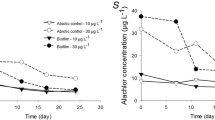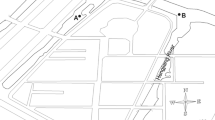Abstract—
The article presents long-term data of abundance and biomass of bacterial biofilms forming on Phragmites australis (Cav.), one of widespread species of the Rybinsk Reservoir higher aquatic plants. Daily production of bacteria and phytoepiphyton is reported, as well as the rate of bacterial degradation of organic matter. The numbers of microorganisms belonging to various physiological groups were determined, and their relative abundance in the total bacterioepiphyton was determined. Epiphyton taxonomic diversity was determined using molecular genetic techniques. Bacteria of the genus Cellvibrio (class Gammaproteobacteria) were found to be responsible for cellulose degradation.


Similar content being viewed by others
REFERENCES
Asaeda, T., Sultana, M., Manatunge, J., and Fujino, T., The effect of epiphytic algae on the growth and production of Potamogeton perfoliatus L. in two light conditions, Environ. Exp. Bot., 2004, vol. 52, pp. 225–238.
Azam, F. and Malfatti, F., Microbial structuring of marine ecosystems, Nat. Rev. Microbiol., 2007, vol. 5, pp. 782–791.
Basberg, L., Banks, D., and Sæther, O., Redox processes in groundwater impacted by landfill leachate, Aquat. Geochem., 1998, vol. 4, pp. 253–272.
Belkova, N.L., Molecular genetic methods for analysis of microbial communities, in Raznoobrazie mikrobnykh soobshchestv vnutrennikh vodoemov Rossii (Divervsity of Microbial Communities in the Inner Basins of Russia), Andree-va, A.M., Ed., Yaroslavl, Printhaus, 2009, pp. 53–63.
Bol’shoi praktikum po mikrobiologii (Large Practical Course in Microbiology), Seliberg, G.L., Ed., Moscow: Vysshaya Shkola, 1962.
Bronmark, C., Interactions between epiphytes, macrophytes and freshwater snails: a review, J. Mollusc. Stud., 1989, vol. 55, pp. 299–311.
Butorin, A.N., Microflora activity in the upper sediment layer of the Northern Dvina lake system, Inf. Bull., Leningrad: Nauka, 1984, no. 64, pp. 3‒5.
Cai, X., Gao, G., Tang, X., Dong, B., Dai, J., Chen, D., and Song Y., The response of epiphytic microbes to habitat and growth status of Potamogeton malaianus Miq. in Lake Taihu, J. Basic Microbiol., 2013, vol. 53, pp. 828–837.
Coci, M., Nicol, G.W., Pilloni, G.N., Schmid, M., Kamst-van Agterveld, M.P., Bodelier, P.L., and Laanbroek, H.J., Quantitative assessment of ammonia-oxidizing bacterial communities in the epiphyton of submerged macrophytes in shallow lakes, Appl. Environ. Microbiol., 2010, vol. 76, pp. 1813–1821.
Corstanje, R., Reddy, K.R., and Portier, K.M., Typha latifolia and Cladium jamaicense litter decay in response to exogenous nutrient enrichment, Aquat. Bot., 2006, vol. 84, no. 1, pp. 70‒78.
Devyatkin, V.G., Phytoplankton composition and productivity in the Rybinsk Reservoir coastal zone, in Presnovodnye gidrobionty i ikh biologiya (Freshwater Hydrobionts and Their Biology), Leningrad, 1983, pp. 52‒70.
Feng, C., Huang, L., Yu, H., Yi, X., and Wei, C., Simultaneous phenol removal, nitrification and denitrification using microbial fuel cell technology, Water Res., 2015, vol. 76, pp. 160–170.
Fischer, H. and Pusch, M., Comparison of bacterial production in sediments, epiphyton and the pelagic zone of lowland river, Freshwat. Biol., 2001, vol. 46, pp. 1335–1348.
Hempel, M., Blume, M., Blindow, I., and Gross, E.M., Epiphytic bacterial community composition on two common submerged macrophytes in brackish water and freshwater, Microbiology (BMC), 2008, vol. 8, art. 58.
Hossell, J.C. and Baker, J.H., Epiphytic bacteria on the freshwater plant Ranunculus penicillatus enumeration, distribution and identification, Arch. Hydrobiol., 1979, vol. 86, pp. 322–337.
Inkina, G.A., Microflora in biofilms on higher aquatic plants, Gidrobiol. Zh., 1989, vol. 25, no. 4, pp. 54‒57.
Islam, J. and Singhal, N., A laboratory study of landfill-leachate transport in soils, Water Res., 2004, vol. 38, pp. 2035–2042.
Kopylov, A.I., Kosolapov, D.B., Rybakova, I.V., and Zabotkina, E.A., Microbial community of reservoir epiphyton: the role of viruses in mortality of heterotrophic bacteria and picocyanobacteria, Usp. Sovr. Biol., 2014, vol. 134, no. 2, pp. 111‒120.
Korelyakova, I.L., Chemical composition of the Kiev Reservoir higher aquatic plants, Gidrobiol. Zh., 1970, vol. 6, no. 5, pp. 20‒28.
Kosten, S., Lacerot, G., Jeppesen, E., Marques, D.D.M., Nes, E.H.V., Mazzeo, N., and Scheffer, M., Effects of submerged vegetation on water clarity across climates, Ecosystems, 2009, vol. 12, pp. 1117–1129.
Kuznetsov, S.I., A method for making preparations for electron microscopy of bacteria from water and lake silt, in Flora, fauna i mikroorganizmy Volgi (Flora, Fauna, and Microorganisms of the Volga River), Rybinsk: Inst. Biol. Vnut. vod AN SSSR, 1974, pp. 303–309.
Kuznetsov, S.I. and Dubinina, G.A., Metody izucheniya vodnykh mikroorganizmov (Methods for Investigation of Aquatic Microorganisms), Moscow: Nauka, 1989.
Lalke, E., Donderski, W., and Blotevogel, K., Role of epiphytic bacteria in the utilization of organic matter, Oceanol. Stud. Mar. Biol. [Pol. Acad. Sci.], 1996, vol. 25, pp. 19–30.
Lapteva, N.A., Rybakova, I.V., Sukhanova, E.V., and Bel’kova, N.L., Structure and functional activity of bacterioplankton in water within macrophytes thickets in the coastal zone of the Rybinsk reservoir, Gidrobiol. Zh., 2015, vol. 51, no. 5, pp. 94‒104.
Larned, S.T., A prospectus for periphyton: recent and future ecological research, J. North. Am. Benthol. Soc., 2010, vol. 29, pp. 182–206.
Liu, J., Liu, W., Wang, F., Kerr, P., and Wu, Y., Redox zones stratification and the microbial community characteristics in a periphyton bioreactor, Bioresour. Technol., 2016, vol. 204, pp. 114–121.
Lyashenko, G.F., Dynamics of higher aquatic vegetation in the Rybinsk Reservoir, Botan. Zh., 1999, no. 12, pp. 106‒111.
Nocker, A. and Camper, A.K., Selective removal of DNA from dead cells of mixed bacterial communities by use of ethidium monoazide, Appl. Environ. Microbiol., 2006, vol. 72, pp. 1997–2004.
Norland, S., The relationship between biomass and volume of bacteria, in Handbook of Methods in Aquatic Microbial Ecology, Kemp, P., Sherr, B., Sherr, E., and Cole, J., Eds., Boca Raton: Lewis, 1993, pp. 303–308.
Odintsov, V.S. and Lapteva, N.A., Nitrogen-fixing activity of epiphytes on som macrophytes in the Sea of Japan, Biol. Morya, 1984, no. 1, pp. 60–62.
Oleinik, G.N., Bacterial degradation of organic matter in basins and channels, Vod. Res., 1991, no. 2, pp. 89–97.
Papchenkov,V. G. and Papchenkova, G. A., Dynamics and Overgrowth of Volga Reservoirs, Water Res., 2020, vol. 47, pp. 591–598.
Papchenkov, V.G., The degree of overgrowth of the Rybinsk Reservoir and productivity of its vegetation cover, Inland Water Biol., 2013, no. 1, pp. 18–25.
Porter, R.G. and Feig, Y.S., The use of DAPI for identification and counting of aquatic microflora, Limnol. Oceanogr., 1980, vol. 25, pp. 943–948.
Qin, B.Q., Song, Y.Z., and Gao, G., The role of periphytes in the shift between macrophyte and phytoplankton dominated systems in a shallow, eutrophic lake (Lake Taihu, China), Sci. China Ser. C, 2006, vol. 49, pp. 597–602.
Rogers, K.H. and Breen, C.M., Decomposition of Potamogeton crispus L.: the effect of drying on the pattern of mass and nutrient loss, Aquat. Bot., 1982, vol. 12, pp. 1–12.
Romanenko, V.I. and Kuznetsov, S.I., Ekologiya mikroorganizmov presnykh vodoemov (Ecology of Microorganisms if Freshwater Basins), Leningrad: Nauka, 1974.
Rybakova, I.V. and Kopylov, A.I., Heterotrophic bacteria in epiphyton of higher aquatic plants in the Ivankovo Reservoir, Inland Water Biol., 2017, no. 2, pp. 239‒242.
Rybakova, I.V. and Vasil’eva, N.I., Microbiological characterization of shallow areas of the Volga stretch, Rybinsk Reservoir, Proc. Int. Conf. “Ecological problems of the basins of big rivers-3,” Tolyatti, 2003, p. 244.
Rybakova, I.V., Bacterial biofilms on abundant species of higher aquatic plants in the Rybinsk Reservoir, Proc. IBIW, Russ. Acad. Sci., 2016, vol. 74, no. 77, pp. 50–58.
Rybakova, I.V., Bel’kova, N.L., Lapteva, N.A., and Sukhanova, E.V., Adapting molecular-genetic methods for studying the taxonomic diversity of microbial communities associated with macrophytes, Inland Water Biol., 2009, vol. 2, pp. 96–103.
Sambrook, J., Fritsch, E.F., and Maniatis, T., Molecular Cloning. A Laboratory Manual, Cold Spring Harbor Laboratory Press, 1989, vol. 2.
Schneider, T., Keiblinger, K.M., Schmid, E., Sterflinger-Gleixner, K., Ellersdorfer, G., Roschitzki, B., Richter, A., Eberl, L., Zechmeister-Boltenstern, S., and Riedel, K., Who is who in litter decomposition? Metaproteomics reveals major microbial players and their biogeochemical functions, ISME J., 2012, vol. 6, pp. 1749–1762.
Shangguan, H., Liu, J., Zhu, Y., Tong, Z., and Wu, Y., Start-up of a spiral periphyton bioreactor (SPR) for removal of COD and the characteristics of the associated microbial community, Bioresour. Technol., 2015, vol. 193, pp. 456–462.
Srivastava, J.K., Chandra, H., Kalra, S.J.S., Mishra, P., Khan, H., and Yadav, P., Plant–microbe interaction in aquatic system and their role in the management of water quality: a review, Appl. Water Sci., 2017, vol. 7, pp. 1079–1090.
Steemann-Nielsen, E., The use of radioactive carbon (14C) for measurement organic production in the sea, ICES J. Mar. Sci., 1952, vol. 18, no. 2, pp. 117‒140.
Stocker, R., Marine microbes see a sea of gradients, Science, 2012, vol. 338, pp. 628–633.
Theil-Nielsen, J. and Sondergaard, M., Production of epiphytic bacteria and bacterioplankton in three shallow lakes, Oikos, 1999, vol. 86, pp. 283‒292.
Timakova, T.M. and Romanenko, V.I., Cellulose bacteria and potential ability to degrade cellulose in the lakes of Karelia, Mikrobiologiya, 1984, vol. 53, pp. 142–148.
Timakova, T.M., Razlozhenie kletchatki v Ivan’kovskom i Uglichskom vodokhrnilishchakh (Cellulose Decomposition in the Ivan’kovo and Uglich Reservoirs), Moscow: Nauka, 1984, pp. 124–139.
Wetzel, R.G. and Sondergaard, M., Role of submerged macrophytes for the microbial community and dynamics of dissolved organic carbon in aquatic ecosystem, in The Structuring Role of Aquatic Macrophytes in Lakes, Jeppesen, E., Søndergaard, M., Søndergaard, M., and Christoffersen, K., Eds., New York: Springer, 1998, pp. 133‒148.
Wu, Y., Xia, L., Yu, Z., Shabbir, S., and Kerr, P.G., In situ bioremediation of surface waters by periphytons, Bioresour. Technol., 2014, vol. 151, pp. 367–372.
Yakushin, B.M., Bacterial development amoinng reed-beds and reed periphyton of the North Crimean Channel, Gidrobiol. Zh., 1978, vol. 14, pp. 36–40.
Yamamoto, M., Murai, H., Takeda, A., Okunishi, S., and Morisaki, H., Bacterial flora in the biofilm formed on the submerged surface of the reed Phragmites australis, Microb. Environ., 2005, vol. 20, pp. 14–24.
Yang, Y., Chen, W., Yi, Z., and Pei, G., The integrative effect of periphyton biofilm and tape grass (Vallisneria natans) on internal loading of shallow eutrophic lakes, Environ. Sci. Pollut. Res., 2018, vol. 25, pp. 1773–1783.
Zhang, L., Zhang, S., Lv, X., Qiu, Z., Zhang, Z., and Yan, L., Dissolved organic matter release in overlying water and bacterial community shifts in biofilm during the decomposition of Myriophyllum verticillatum, Sci. Total Environ., 2018, vol. 633, pp. 929–937.
Zhao, B., Xing, P., and Wu, Q.L., Interactions between bacteria and fungi in macrophyte leaf litter decomposition, Environ. Microbiol., 2021, vol. 23, pp. 1130–114.
Zhao, B., Xing, P., and Wu, Q.L., Microbes participated in macrophyte leaf litters decomposition in freshwater habitat, FEMS Microbiol. Ecol., 2017, vol. 93. fix108.
ACKNOWLEDGMENTS
The authors are grateful to S.A. Kurbatova for her help in editing the manuscript, to A.I. Kopylov for material support and consultations related to the work, and to S.E. Bolotov for hius assistance with computer graphics.
FUNDINGThe work was carried out within the framework of the State Assignments nos. 121051100102-2 and 121051100109-1 and was supported by the Russian Foundation for Basic Research, project no. 09-04-00977 and the Biological Resources of Russia Program of Basic Research, Russian Academy of Sciences.
Author information
Authors and Affiliations
Corresponding author
Ethics declarations
Conflict of interests. The authors declare that they haveno conflict of interest.Statement on the welfare of animals. This article does not contain any studies involving animals or human participants performed by any of the authors.
Additional information
Translated by P. Sigalevich
Rights and permissions
About this article
Cite this article
Fedorov, R.A., Rybakova, I.V., Belkova, N.L. et al. Structural and Functional Characterization of Bacterial Biofilms Formed on Phragmites australis (Cav.) in the Rybinsk Reservoir. Microbiology 91, 324–335 (2022). https://doi.org/10.1134/S0026261722300105
Received:
Revised:
Accepted:
Published:
Issue Date:
DOI: https://doi.org/10.1134/S0026261722300105




